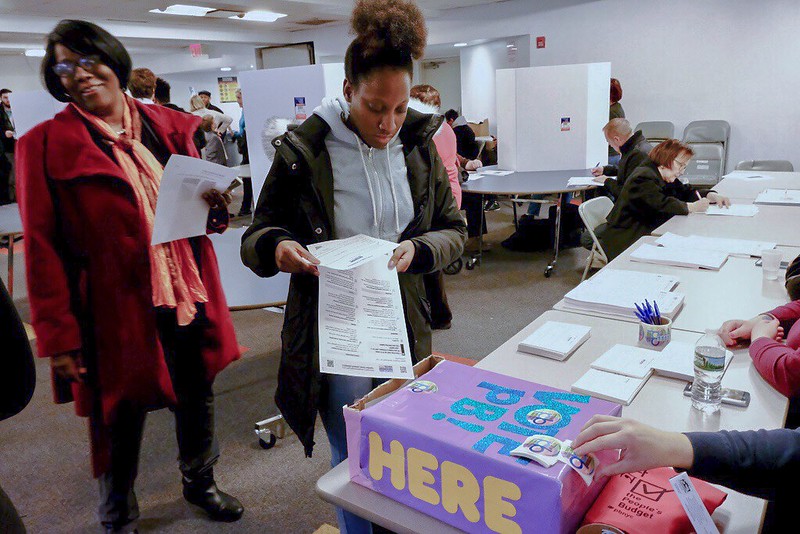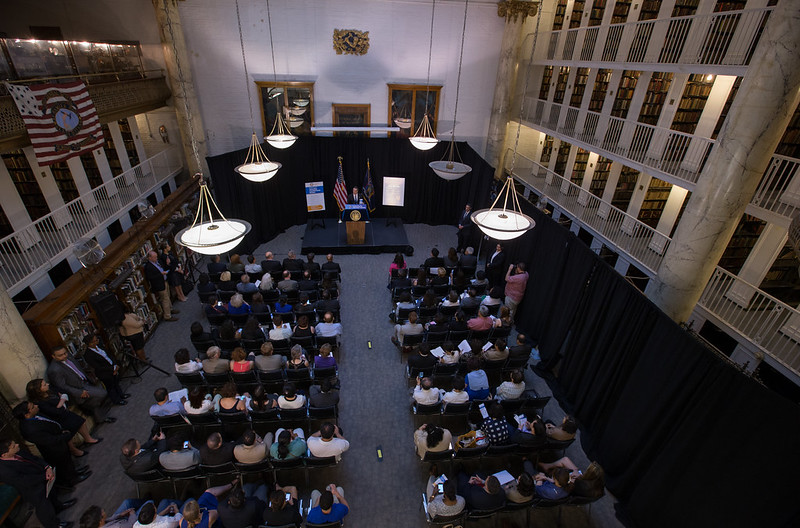The Candidate That Wins Should Get At Least Half The Votes

(photo: City Council)
Suppose eight candidates are running for Mayor or a City Council seat or another New York City office. On election night, the results are extremely close: The top candidate gets 29% of the vote, and the second 28%. Even though 70% of voters picked someone else, a candidate with less than one-third of the votes will become the elected representative of 100% of the office’s jurisdiction.
This situation may seem unlikely, but it’s precisely what happened in a 2013 special election for New York City Council, when Donovan Richards defeated special election opponent Pesach Osina by only 79 votes. The district is mostly African-American, and except for Osina, the candidates were African-American. However, because the vote was split among six African-American candidates, Osina almost became the district’s nominee with only 28% of the vote. This election was not that unusual: In 2013, 14 of the 21 New York City Council primaries for open seats were won with less than 50% of the vote.
Ideally, in a democracy, candidates supported by a majority of voters get elected. We can make that happen in New York City. Starting with early voting, October 26-November 3, and on Election Day, November 5, New Yorkers can ensure candidates supported by a true majority of voters are elected by voting “yes” on ballot question one, which would adopt ranked-choice voting for primary and special elections starting in 2021.
Under the ranked-choice voting method proposed by question one, rather than voting for a single candidate, voters rank candidates by order of preference from 1 to 5. If a candidate gets a majority of first-choice votes, the candidate wins, election over. But if no one hits 50%, the winner is the candidate with a majority of 1st- and 2nd-choice votes (and 3rd-, 4th-, or 5th-choice, if necessary to hit 50%). If the candidate you ranked first receives the fewest first-choice votes, that candidate has lost, and your vote is transferred to the candidate you ranked second. That would be the case for all the voters who chose that last-place candidate. This process is then repeated until a candidate hits 50%.
Ranked-choice voting has already had a major impact in places like Oakland, California. In a ten-way race for the city’s mayor in 2010, candidate Don Perata was in the lead after the first round tally, with 34% of votes, compared to 24% for second-place Jean Quan. However, after the eight other candidates were eliminated and votes were transferred, Quan pulled ahead and won with 51% of the vote to Perata’s 49%. Quan was the preferred candidate of those who hadn’t put her or Perata as their first choice, and by voters overall.
If question one passes this fall and New York City is home to ranked-choice voting for primary and special elections, candidates will be forced to reach the largest possible number of voters while campaigning. Conceivably, the system could encourage more positive campaigns, as under ranked-choice voting, candidates sometimes cross-endorse in an effort to build support, and candidates generally want even people they may not be able to convince to put them first to choose them second.
It may increase voter turnout – it helps when people know their vote counts – and the initiative will save New York City millions of dollars by ending runoff elections (which occur for citywide races when no candidate receives 40% of the vote).
Ranked-choice voting will also arrive at a time when more Americans are running for office than ever. Now that candidates for office in New York City can have 89% of their campaign funds come from the city’s campaign finance system, the number of New Yorkers campaigning may hit all-time highs. With more than 30 City Council seats open, as well as two citywide seats and at least four borough presidencies, the New York City Campaign Finance Board projects that up to 500 New Yorkers will run for office in the 2021 elections alone. With so many options to choose from, it’s crucial that the results reflect the will of the majority. Ranked-choice voting ensures that the majority is heard.
At a time when many state and local governments are moving to take power from voters, we need initiatives like ranked-choice voting that give power to voters. This fall – starting with early voting October 26-November 3 and on Election Day, November 5 – New Yorkers can make their city a leader in electoral reform and help restore democracy’s greatest promise: People matter.
***
Tom Speaker is a policy analyst at Reinvent Albany. On Twitter @ReinventAlbany.
***
Have an op-ed idea or submission for Gotham Gazette? Email This email address is being protected from spambots. You need JavaScript enabled to view it.
Mass Incarceration and Remorse

(photo: the governor's office)
Dallas Police Officer Amber Guyger faced up to 99 years for killing her neighbor, Botham Jean, in his own home. According to most observers, the forgiveness offered by Mr. Jean’s 18-year-old brother in his victim impact statement, capped by his request to hug Ms. Guyger, was the key reason why the jury settled on 10 years, a far lower number than even the 28 years urged by the prosecutor.
However important a role forgiveness played in the jury’s decision to spare Guyger decades behind bars, according to interviews with some of the jurors an even greater factor was Guyger’s expression of remorse during her trial testimony: “I’m so sorry,” she said. “I never wanted to take an innocent person’s life...I wish he was the one with the gun that killed me.”
The role of remorse in sentencing and punishment was a central theme of the recent Parole Summit organized by the Lifers and Longtermers Organization at Otisville Correctional Facility in New York.
In years past, the Summit focused on the parole process itself -- the parole interview, the parole decision, and appeals from parole denials -- and yielded suggestions for reforming an unforgiving system. But this year, the lifers decided to look inward, and bring to the forefront conceptions of restorative justice, victim centered awareness, and individual transformation.
The overarching emphasis on healing led inexorably to exhortations for offenders to gain insight into what led them to their crimes; to reflect on the motivations for their behavior. Many of the day’s speakers stressed that the lifers had to accept responsibility for the harm they caused, and to develop and express authentic contrition in order to promote healing for themselves as well as for their victims.
Criminal legal systems place a premium on remorse. Studies here and abroad have shown that remorse is the most commonly named mitigating factor for a reduced sentence, and perceived lack of remorse often leads to an enhanced sentence. Remorse is specifically and instrumentally relevant to the Parole Summit – most states allow parole boards to consider a person’s insight and remorse when deciding whether to grant parole, and parole boards typically probe those areas in depth at parole interviews. Many lifers have been denied parole based on a perceived lack of genuine or sufficient remorse.
Many rationales explain the outsize role remorse plays in sentencing and punishment. Sincere remorse as a sign of moral improvement suggests that the person has been rehabilitated and no longer poses a danger. Expressions of remorse also have a confessional aspect and are preconditions to receiving understanding or forgiveness. Remorse also serves as an apology to the victims and restores a measure of dignity that the crime violated.
But remorse is an emotion. Can anyone accurately evaluate whether a statement of remorse is genuine or self-serving? Typically, determinations of the authenticity of remorse are made by judges and members of parole boards who lack any training or special competence in assessing the complexities of human emotions. How do these evaluators distinguish remorse from guilt or from shame, or just generally decide whether a person is being sincere? Some people are better able to verbalize their feelings than are others, and cultural differences surely influence evaluations of remorse. How is remorse gauged when a person professes their innocence?
Studies show judges disagree about indicators of remorse – behavior that indicated remorse to some suggested remorselessness to others. Research has debunked the notion that remorse can be evaluated by words used, non-verbal cues, attitudes, and demeanor.
The many lifers denied parole for alleged inadequate contrition recognize that their words are necessary but not sufficient. It is too easy for words to be dismissed as uttered only in the hope of obtaining freedom. Instead, lifers want their remorse to be judged by their actions and deeds as well as by their words; by the affirmative steps they have taken while incarcerated to try to make amends for the harm they caused.
The reality of the enduring impact of remorse revealed a fundamental irony as the lifers listened patiently and attentively to remarks from prosecutors, members of the parole board, elected officials and others. While all the speakers talked about their reforms and self-defined progressive policies, something was missing.
Seated silently next to me was a man serving 50 years to life as a high-ranking prosecutor from the office that prosecuted him talked about all his office is doing in progressive criminal justice. Another man at my table who has been denied parole six times listened stoically as a parole board member talked about the virtue of accepting responsibility and expressing concern for victims – something the man has done to no avail at every one of his six parole appearances
By now, most people agree that prosecutors and those connected with law enforcement were the primary architects of mass incarceration. Yet what was sorely lacking from the speakers extolling the righteousness of victim-centeredness and offender accountability was any acknowledgement and acceptance of their individual, or their office’s, responsibility for the blight of mass incarceration. There was nothing said that remotely resembled insight, remorse, or apology.
And while words matter, in the end, just as lifers beg not to be judged solely by the words they utter in a brief and nerve-wracking parole interview but by their actions over the past many decades -- the things they have accomplished in prison and the men and women they have become -- law enforcement actors should be similarly judged.
Words matter, they are necessary if there is to be any reconciliation for past harms, but ultimately actions speak louder than words. If those who caused the crisis of mass incarceration and resultant decimation of families and communities cannot bring themselves to publicly accept responsibility and offer contrition to the tens of thousands of men and women serving life and massive long-term sentences, they can at the very least show their genuine and authentic remorse by taking every necessary step to secure their release.
***
Steven Zeidman is a professor of law at CUNY School of Law. On Twitter @SteveZeidman.
***
Have an op-ed idea or submission for Gotham Gazette? Email This email address is being protected from spambots. You need JavaScript enabled to view it.
State Health Department Must Reject Unneeded, Burdensome Luxury Hospital Expansion

rendering of proposed Leonx Hill Hospital expansion
Northwell Health is proposing an unprecedented, $2.5 billion expansion of Lenox Hill Hospital that includes construction and sale of a 490-foot condo tower to help finance a new 520-foot hospital tower and other massive new structures. This pitch has already generated much controversy, as residents of the Lenox Hill neighborhood and surrounding communities are speaking out forcefully against Northwell’s plan.
While it is widely understood that this development plan must go through the city’s land use approval process (known as ULURP) because of zoning changes Northwell is seeking, many New Yorkers are unaware that Northwell also needs approval from the State Department of Health before it can proceed with any expansion of Lenox Hill Hospital.
The crucial point here is that Northwell must apply to the State DOH to receive a “certificate of need” for its expansion plan. But the facts show that there truly is no need for this proposed expansion on the Upper East Side – and that is why the State DOH must reject the plan and send Northwell back to the drawing board.
This is a matter of common sense. In order to be granted a certificate of need, an institution should be able to demonstrate that its proposal promises to deliver something that is actually needed by the community. When it comes to Northwell’s plan for Lenox Hill Hospital, that is not the case.
We can all agree that Lenox Hill Hospital must offer high-quality, state-of-the-art medical care in a well-maintained facility. And if a straightforward modernization plan were all that Northwell were proposing, it would be worthy of support. In fact, it appears that Northwell has already begun financing its own upgrades at Lenox Hill Hospital, with a recent news story noting that officials have “hired a Michelin Star Chef” and made numerous other cosmetic improvements to provide a “luxury hotel experience.”
But the idea of building a monstrous luxury condo tower in the midst of a historic residential district to finance single-occupancy hospital rooms and destination medical facilities in one of the city’s most affluent and well-served areas is grandiose and insulting to community residents. Simply put, we do not need more hospital beds and significantly larger hospital facilities on the Upper East Side – and our community is not asking for them.
Let’s be clear: there are already more than 10,000 hospital beds in Manhattan, at least 3,000 of which are located throughout the Upper East Side. Our communities have access to healthcare facilities and specialty medical care that are the envy of our other-borough neighbors, many of whom have demanded better access to quality medical care.
Want to talk about healthcare needs? Look at the South Bronx, where low-income residents suffer from the state’s highest asthma rates. Look at Central Brooklyn, where national experts have called that community’s hospitals some of the worst in the entire nation.
If Northwell were truly interested in developing an expansion plan worthy of a “certificate of need,” it would seek out ways to bring more of its high-quality healthcare resources to communities like these. Instead, it is advancing a lucrative real estate development pitch that will create the tallest hospital in New York City and serve primarily to reap profits for its grandiose vision and satisfy the egos of its senior executives. All of this will take place at the expense of the local neighborhood, which will be forced to endure 10 years of hazardous construction and a massive condo tower that will destroy the fabric of a historic community.
The bottom line here is that if the State Department of Health follows its mandate to serve the healthcare needs of all New Yorkers and takes a thoughtful approach to evaluating these types of proposals, it has no choice but to reject Northwell’s plan and compel the institution to rethink its approach.
***
Andy Soussloff is a Lenox Hill resident and a member of the non-profit Committee to Protect Our Lenox Hill Neighborhood, Inc.
***
Have an op-ed idea or submission for Gotham Gazette? Email This email address is being protected from spambots. You need JavaScript enabled to view it.




